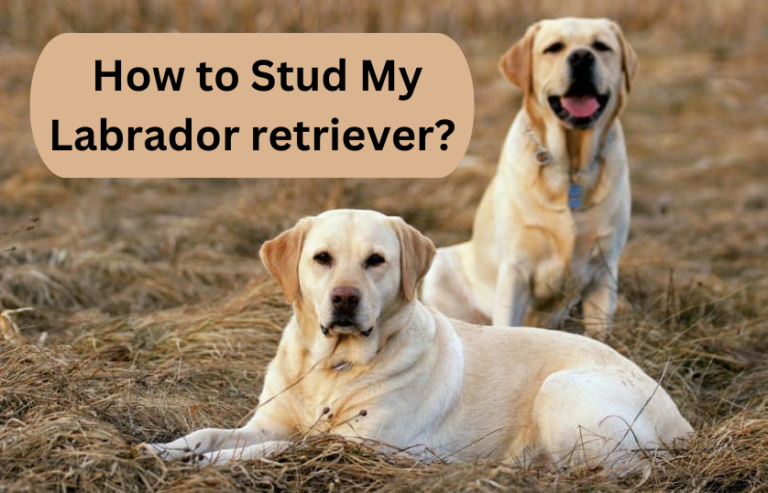German shepherd mixed with Labrador retriever: Useful Guide in 2025
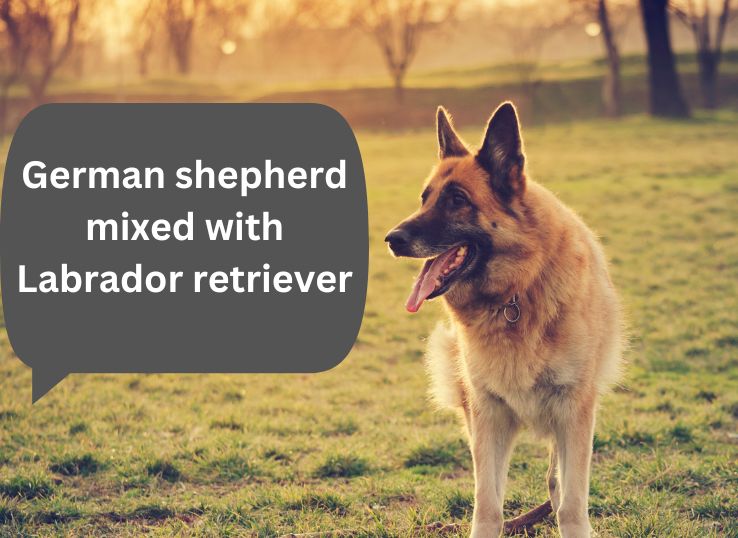
If you want to get a German shepherd mixed with Labrador retriever or you have adopted one, then this article will help you. You will better recognize what this hybrid breed is and how to care for this German shepherd Lab mix daily. I am happy that you will grow a healthy German Shepherd Labrador mix dog.
Table of Contents
German shepherd mixed with Labrador retriever overview


| Common names: | German shepherd lab mix, German sheprador, and labrashepherd |
| Origin: | Unidentified |
| Parent breeds: | German shepherd and Labrador |
| Breed group: | Cross |
| Size: | Large |
| Height: | 20 to 27 inches |
| Weight: | 75 to 95 pounds |
| Colors: | Tan, black, chocolate, cream, and mixed color |
| Coat: | Double coat, short, and medium length |
| Life expectancy: | 10 to 12 years |
| Temperament: | Friendly, faithful, protective, energetic, loving |
| Shedding: | Moderate or heavy shedders |
| Barking tendency: | Minimal |
| Cost: | $700 to $2,000 |
3 Facts About Lab Mixed with German Shepherd
1. These Are Smart Dogs
When we talk about intelligence, the German Shepherd mixed with Labrador retriever wins hands down. Its parent dogs are top-notch canines, which is why these pooches are used as guard dogs, service dogs, as well as police dogs.
2. These Dogs Are Trustworthy Guard Dogs
The Labrador and the German Shepherd dogs are faithful and will look after their family and property at all costs. German shepherd dogs are courageous, amusing, and can be trained easily. Labs will bark once they feel danger.
3. German Shepherd lab mix will make you active.
You will become active with this hybrid breed. You can become healthier as this dog requires long walks and more hours of playtime. Your Lab German Shepherd mix will become your coach.
History of the German Shepherd Mixed with Lab
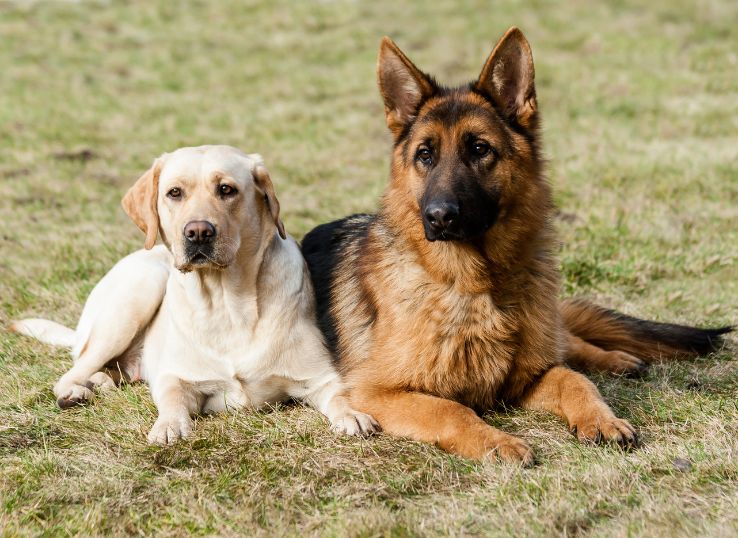
Only a little is recognized about when these hybrid canines first appeared. There’s a great chance that, like numerous other designer dogs, the German Shepherd mixed with Labrador retriever was first developed by chance.
Dogs are fully capable of hybridizing on their own. Indeed, numerous purebred dogs I know are a consequence of centuries of cautious breeding. This crossbreed is a direct outcome of breeding pedigree German Shepherds with Labrador Retrievers.
Labs have come initially from the Labrador area of Canada. They were working canines that frequently helped out fishermen. Ultimately, these dogs came to England and became friends with European royals.
German Shepherds were working pooches, too. But, their crucial job was to herd sheep and cows for farmers. Due to genetic studies, professionals could govern that the pedigree we’re familiar with came from numerous herding dog breeds all over France and Italy.
Nowadays, Labradors, as well as German Shepherds, are very prevalent all over the world. However, they are prevalent for very different reasons. Usually, Labs are recognized for their companionship. They are great family pets and are frequently used as guide canines for those with infirmities.
Meanwhile, German Shepherds are admired for their athleticism and cleverness. You’ll frequently see these dogs working with law enforcement, army personnel, and more.
German Shepherd Lab Mix Temperament
The attractiveness of hybrid dogs is that they receive traits from their parents. German Shepradors are an ideal example of this. These canines are a happiness to be around. They immensely love and need nothing more to gratify their families. Whether that desired physical work or outstanding behavior, these dogs are up for the job!
The common misunderstanding is that pure German Shepherds are violent, making some people worried about the hybrid breed. German Shepherds are highly defensive of the people that they love. They’re viciously trustworthy and keen to please. Because of this reason, they’re very easy to train for hard jobs like law enforcement.
German Shepherds and their consequent crossbreed are products of their atmosphere, like all canines. If they are grown in a good home and obtain proper socialization, these canines won’t have any problems. It’s all about giving appropriate training.
German shepherd mixed with lab makes excellent family dogs. The blend of smart thinking and faithfulness can be beneficial in a home setting.
Intelligence and Training
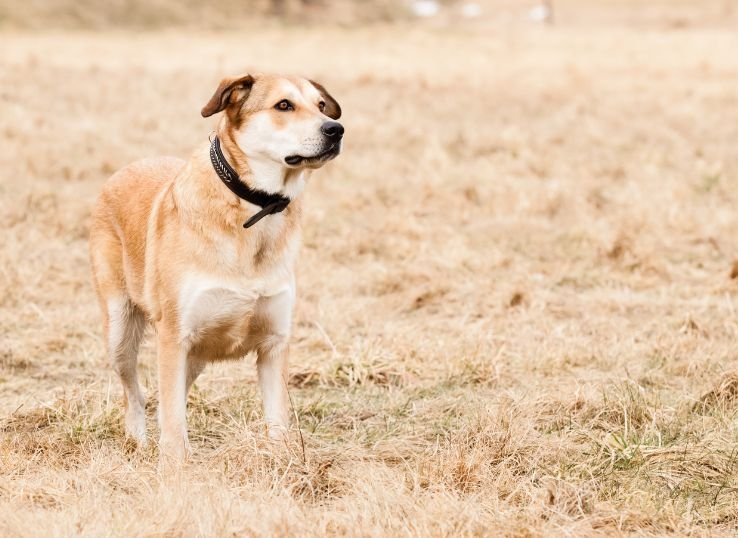
Training a German Shepherd Lab mix isn’t very difficult for people with some experience. These dogs can be a bit useful for beginner dog owners who aren’t familiar with recognized training methods. However, aiding your pup to grow up to be respectful and well-mannered is controllable.
You see, these canines are very intelligent. Indeed, some think they are too smart for their own good. This primarily comes from the German Shepherd parent. German Shepherds are famous for being stubborn. They’re susceptible to being a bit self-governing and overthinking instructions.
German shepradors can carry that personality feature, making the training more interesting. They need more time and endurance to recognize things truly. Another problem with German Shepherd Lab mixes is the requirement for regular mental inspiration.
As they are so smart, you must continuously challenge their minds to keep them happy. Mental encouragement toys, like puzzle feeders, can do miracles to have your dog’s mind busy. It will stave off bad activities and keep them sharp!
Like all canines, German shepradors do best once positive reinforcement is the training technique of choice. Although dominance-based training is considered the go-to, numerous studies have revealed that punishments do more injury than good. Punishing your dog will only cause them to have negative feelings about you.
German Shepherd mixes flourish once you use a reward. Showering your pooch with praise and giving lots of treats is the best approach to instill the training procedures.
Stature and Weight
Both parent breeds for German shephradors are deliberated to be large dog breeds. Consequently, the hybrid is going to fall into that same class. You can use info regarding their parents for reference; however, numerous factors will back their true adult size.
Usually, males can weigh around 88 pounds once fully grown. They will stand 22 to 26 inches at the withers. Females usually are smaller than males. You might consider females as small as 35 pounds. However, most will be approximately 70 to 80 pounds. Besides, females can be between 20 to 24 inches at the withers. Yet again, all dogs are not the same, and there’s a lot of dissimilarity depending upon the parents.
Common Physical Features
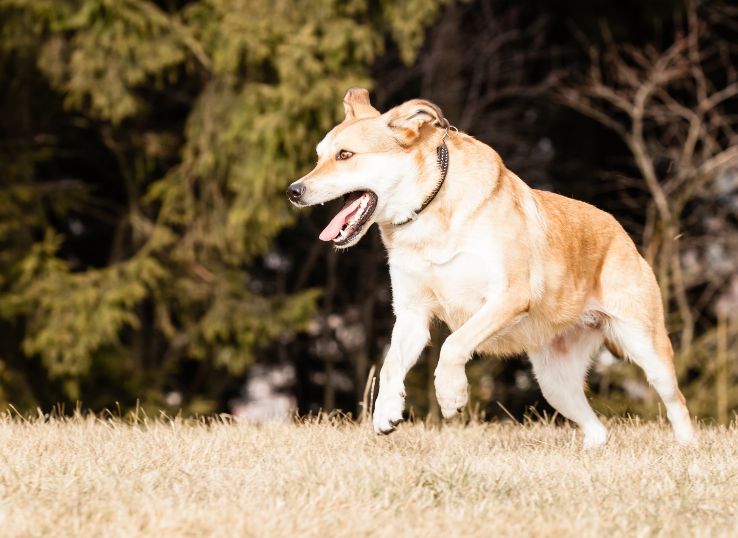
German Shepherd mixed with Labrador retrievers can take on various physical features. Both parent dogs are fit, so that most hybrid pups will be too. These canines aren’t crazy muscular but not as thin as other pooches.
They fall anywhere in the middle. You can observe strong muscle growth on their hind limbs based on their activity levels. These dogs frequently have wide noses and dark noses. Their eyes are big and brown.
Some pups might have light eyes; however, this is relatively infrequent. Genetic differences in the parent breeds can make lighter eyes; however, several puppies will have large brown eyes.
One feature where you will notice a lot of dissimilarity among these canines is the ears. Most Labrador retrievers have large, floppy ears. In the meantime, cheerful triangular ears are one of the most significant characteristics of the German Shepherds. For the hybrid dogs, it depends upon luck!
Colors
Coat colors can differ with these pups. German Shepherds contain an iconic tri-color fur. Distinct outlines of gold, black, as well as white cover the body. Whereas labs don’t have a multi-colored appearance, they have a few different fur colors. The most common color is gold. But black as well as pure-white Labs occur as well.
When these two dogs mix, there are plenty of options for the offspring. They might have multi-colored furs or solid ones. It depends on which parent dog’s genes are more prevailing.
Lifecycle
The average life for a German Shepherd Lab mix is approximately 10 to 12 years. Usually, larger dogs might have a shorter life expectancy compared to smaller ones. Numerous factors will influence how much time these canines have. Health problems and a poor routine can cut that lifecycle short. Healthier puppies can live 12 years of age.
Possible Health problems in German shepherd Lab mix

German shepradors are not resistant to disease and health difficulties like all dogs. They might be prone to more problems. The problem with hybrid breeds is that it opens up the likelihood of health problems in the future.
Hereditary issues from both parents can be delivered to the puppy. Awkwardly, German Shepherds, as well as Labrador Retrievers, are recognized to suffer from some different illnesses. Here are some health worries to be wary of.
1. Bloat
Contrary to prevalent acceptance, bloat is not an innocent gas issue with dogs. Also known as Gastric Dilation and Volvulus, or GDV, this problem can be a dangerous problem. It happens when dogs consume too fast or use physical exercise quickly after eating.
Extra air is swallowed, filling their stomach. Ultimately, the stomach can rotate on itself. This hampers blood flow in the body. If it’s not managed immediately, GDV can be deadly. The best approach to avoid bloat is to focus on the dog’s eating timetable.
Offer small meals, and do not allow your dog to play for 30 minutes. To manage fast eating, you can consider slow-feeding bowls and puzzle toys. They generate a hindrance that forces the pooch to swallow slower than normal, which can prevent GDV.
2. Hip and Elbow Dysplasia
Although dysplasia can affect any big dog, it’s most common in German Shepherds. It is a musculoskeletal problem that frequently affects dogs in future life. In numerous cases, it’s a genetic problem. But, it takes a few years to progress and can be caused by problems as a young pup.
Take hip dysplasia as an instance. Hip dysplasia can cause devastating pain. Numerous dogs who experience it have a difficult time standing up. They might display signs of thrilling weakness in the hind limbs, causing a remarkably different posture.
The hip sockets get malformed, resulting in mobility problems with the hip joint. Although some canines are born with it, poor growth as a puppy can worsen the issue. It’s thought that overweight pups are more prone as additional pressure is put on the gentle bones and joints.
There are treatment choices for hip and elbow dysplasia. Vets can do surgery early on to resolve the problem and give relief. If your pooch is already experiencing it, physical therapy, as well as joint supplements, can give relief from pain.
3. Ocular Problems
Eye infections, for example, progressive retinal atrophy, are very common with parent dog breeds. The tissue inside the eye can be decadent with time. This leads to vision loss. Unluckily, there’s no approach to treat the infection.
Several breeders will monitor the genes that cause it. From there, you can offer supplements or foods high in beta-carotene to slow its development.
4. Obesity
Like Labrador retrievers, German shepradors are susceptible to obesity. Lab outcomes have found that Labradors have lost the entire POMC gene, which causes body fat storage and controls appetite.
Don’t overfeed the pooch and don’t let treats to make up above 10% of the pooch’s calories. Give this mix sufficient exercise to prevent weight gain.
5. Skin Allergies
German shepherd lab mixes are delicate to mites, dust, pollen, as well as chemicals, which cause scratchy skin and skin allergies. Inflammation, rashes, itching, infections (particularly around the ears), and loss of hair are all common symptoms of skin allergies in canines. Treatment for skin allergies comprises diet changes, controlling triggers, and medicine to decrease itching.
Training
Labrashepherds are smart dogs that enjoy being admired,; thus, they’re easy to train using a basic command, plus reward tactic. Steady training is significant for this breed; thus, train your canine for at least 15 minutes daily.
Start training your dog from the age of 8 weeks. The primary 6 months of the pooch’s life is the most precarious learning period; thus, ensure to cover all simple training, comprising toilet and leash training, simple commands, and early socialization.
German shepherd Labrador retriever mixes are high-energy canines, so a pooch that isn’t reacting well to training can feel too spirited to focus on training. To avoid this, train your pooch during a long walk.
Diet and Exercise Requirements
Shepherd Labrador mixes are extremely active dogs. They like nothing beyond playing and doing lots of exercise. It’s significant to provide these dogs with as numerous opportunities to spend their energy as possible.
It’s suggested that they exercise around 90 to 120 minutes daily! If you don’t, your pooch will be at a greater risk of health problems. German shepherd mixed with Labrador retriever is susceptible to gaining weight once they don’t exercise sufficiently. To make matters severe, a deficiency of exercise can cause a lasting issue.
If puppies aren’t allowed to exercise every day, they can get bad routines and become quite lethargic as adults. You should start your puppy on the right path and create a healthy routine immediately. Consider walks and tossing chew toys near the yard.
You can cut exercise time into adaptable chunks during the day. If you have those 90 minutes in, your pooch should have no issue remaining healthy. When we talk about diet, you must be just as attentive!
These dogs have greedy appetites. Getting something they want won’t be a problem. However, you have to ensure that their food fulfils all nutritional requirements. Your dog’s best friend desires food that’s full of protein.
It should have wholesome proteins such as chicken, beef, or fish. Your dog food must have complex carbohydrates and healthy fats such as fish oil. The goal is to offer your dog muscle-forming protein to keep their body in good shape.
Observe ingredient lists and don’t allow price to affect your choice too much. The dog food you select will greatly affect the dog’s well-being; thus, take some time to select the right dog food.
Dogs will require around 30 calories of food for every pound of body weight. This frequently amounts to approximately 4 cups of dry kibble daily. That said, dog foods can differ dramatically when we consider nutritional density. Talk about the package and consider your canine’s size while planning meals.
I suggest splitting their caloric needs into two small meals daily. One meal during the morning and one meal in the evening will retain their energy levels constant as they go about their lively lifestyles. Moreover, splitting the meals will aid in avoiding concerns like bloat.
Mental Requirements
Give at least 30 minutes of everyday mental encouragement to keep your German shepherd mixed with lab happy and satisfied. The breed is smart and likes playing hide-and-seek, fetch games, as well as puzzle games by food release dog toys.
Labrashepherds are identified to be destructive once they’re bored; therefore, provide your dog with loads of toys for amusement when you’re busy.
German Shepherd Lab Mix Grooming Requirements
Your dog’s coat grooming will depend completely on its density as well as length. It’s always better to brush dogs frequently to avoid matting and knotting. However, thick furs require a bit of additional work.
German shepherds have double prices. The outer layer of the coat is thinner and easier to handle. In the meantime, the inner fur is thick and dense. It delivers insulation in the winter months.
German Shepherd Lab mixes can get that thick fur. If your dog has double fur, you’ll have to brush them after a few days. They will experience shedding cycles several times a year, leading to a mess of hair in your home!
With steady brushings, you can retain the fallout to handy levels while having your puppy clean.
Types of Lab German Shepherd Mixes
There is only one category of German Shepherd accessible. There aren’t any dissimilarities like there are with purebreds. The American Kennel Club does not accept these canines; therefore, they’re not an authorized breed with standards.
Regardless of all of this, you might see puppies with immensely different features. German Shepherds, as well as Labrador Retrievers, don’t have many characteristics in common when it comes to appearances’ thus, you can encounter some exceptional pups with very discrete traits.
Genetics is not a thorough science. Leading genes from one parent pooch might take over, letting the puppy appear more like one parent dog breed than the other.
How much is a Lab German Shepherd Mix?
A Lab German shepherd mix normally costs $700 to $2,000. Factors that influence the cost of the pooch are age, coloring, adoption, and purchasing from a breeder.
Adults are around $500 cheaper than pups. Adoption fees are approximately $200. Canines with infrequent coat colors are more costly than canines with common colors.
Is a Lab German Shepherd Mix the Right Breed for You?
The Lab German shepherd mix is a loving, loyal, active dog that makes an excellent family pet. However, this pooch has a personality that makes it inappropriate for some individuals and lifestyles.
Who Should Buy a German Sheprador?
German shepradors are high-energy canines that are perfect for active, outdoorsy families. The dogs are loving and approachable; thus, they’re good family pets. German shepradors are alert to training if appropriate boundaries are recognized; therefore, this mix is the best fit for individuals who have the time for their dogs from a young age.
Who Should Not Buy a German Shepradors?
German shepradords have plenty of energy to burn; thus, they’re inappropriate for apartment living or lazy owners. The dogs are recognized to chew furniture and woof when left alone, therefore they’re not great pets for individuals who spend more time away from their home.
FAQs
Is a German shepherd Labrador mix a good dog?
German Shepherd Lab Mixes are adorable dogs that make outstanding pets; however, they require a lot of exercise, affection, and care, which means they aren’t perfect for every family. They do best with energetic people or households full of individuals who love them.
Is a Labrador retriever smarter than a German Shepherd?
German Shepherds are at #3, and Labradors are at #7 for most smart dog breeds. Thanks to the German Shepherd’s cleverness, trainability, as well as obedience, they were primarily bred as working canines to herd sheep.
Conclusion
German Shepherd mixed with Labrador retrievers are a happiness to raise. If you keep an active routine to keep them healthy, they will be an outstanding addition to your house. Although they may take more time to train than most big breeds, they can learn complex tasks effortlessly. So, treat them well, and these dogs will spend their whole lives being affectionate dog companions



